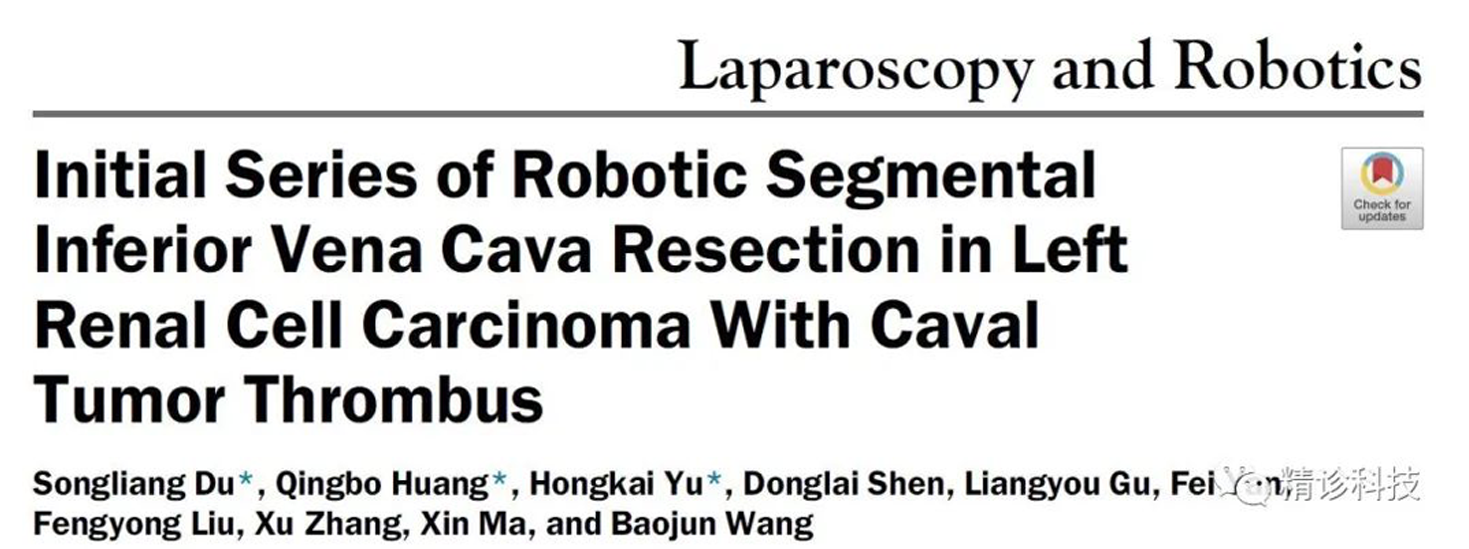 您的位置:首页 > 资讯动态
您的位置:首页 > 资讯动态
近期,临床外科人工智能医疗企业精诊科技与中国人民解放军总医院第一医学中心张旭教授(中华医学会泌尿外科分会候任主委)、马鑫教授、杜松良医生合作在国际泌尿学顶级SCI杂志《UROLOGY》上发表临床研究成果。
论文系统阐述了精诊科技“TrueSight®”人工智能技术,在此类病变手术治疗创新性应用。通过三维重建,精准展示肾静脉及下腔静脉侧支循环结构,为医生术中精准阻断血管提供更为可靠的参考依据。

论文题目
精诊科技医工结合,发挥独特的技术优势,显著提高了手术决策的成功率,进一步完善了肾癌伴下腔静脉癌栓的微创治疗体系,为医生提供强有力的技术支持。
对于肾细胞癌合并下腔静脉癌栓的患者来说,根治性切除肾癌的同时切除下腔静脉癌栓可以获得良好的预后,但是由于术中分离肿瘤时挤压下腔静脉可能导致癌栓脱落引起肺栓塞,手术风险极大。
医生需要通过下腔静脉造影和计算机断层扫描(CT)来综合评估侧支循环的情况,判断是否需要下腔静脉重建。
中国人民解放军总医院第一医学中心肾脏疾病重点实验室、放射科、介入放射科医生,选取2017-2018年之间7例左肾细胞癌伴下腔静脉癌栓患者,术前使用精诊科技“TrueSight®”人工智能技术对CT影像进行了三维重建。
同下腔静脉造影相比,精诊科技的人工智能血管追踪技术可以更为精细地展示肾静脉及下腔静脉侧支循环,帮助医生评估侧支循环是否充足,并通过模拟切除右肾静脉上方和第二肝门下方的下腔静脉部分,观察切除术后可能的右肾静脉引流途径。

清华智能疫情防控体系
第一排右二为精诊临床AI辅助分析系统
精诊“TrueSight®”AI三维重建结果与术中所见吻合
7名患者均接受了左肾细胞癌切除及下腔静脉部分切除术,无需下腔静脉重建,术后恢复良好。该研究表明,精细化的血管追踪重建技术在此类手术中等同下腔静脉造影具有显著效果。
“张旭教授认为,任何一场胜仗,都离不开团队的通力合作,强有力的医疗技术支持和组织协调保障显著提高了手术决策的成功率。”
bstract
OBJECTIVE
To present our preliminary experience of robotic left radical nephrectomy (LRN) and segmental inferior vena cava (IVC) resection without caval replacement for left renal cell carcinoma (RCC) with inferior vena cava tumor thrombus.
MATERIALS AND METHODS
Between 2017 and 2018, 7 patients underwent segmental IVC resection and LRN robotically. All patients underwent preoperative cavography, demonstrating complete IVC occlusion. Computed tomography-based 3-dimensional reconstruction revealed sufficient collateralization of the IVC and right renal vein (RRV). The cephalic IVC was circumferentially resected and ligated just below the second porta hepatis. The caudal IVC was circumferentially resected above the RRV with preservation of the major collaterals. The RRV was not dissected during the procedure to avoid compromising its neocollaterals. The IVC portion between the RRV and the second porta hepatis was removed en bloc with the tumor thrombus, and the LRN was performed.
RESULTS
All cases were successfully performed by robotic surgery without conversion. Median operative time was 420 minutes. Median intensive care unit stay was 3 days. Four grade Ⅱ complications occurred in 2 patients. One patient had mild LEE postoperatively and recovered without special medication. Median preoperative and 3-6 months follow-up serum creatinine was 118.7 mmol/L and 135.2 mmol/L, respectively. No patient needed dialysis postoperatively. One case occurred disease progression. No patient died during the follow-up period.
CONCLUSION
Robotic segmental IVC resection for left RCC with inferior vena cava tumor thrombus is feasible in well-selected cases. Three-dimensional reconstruction and cavography are helpful in the preoperative evaluation of neocollaterals in patients with suprarenal IVC occlusion.
